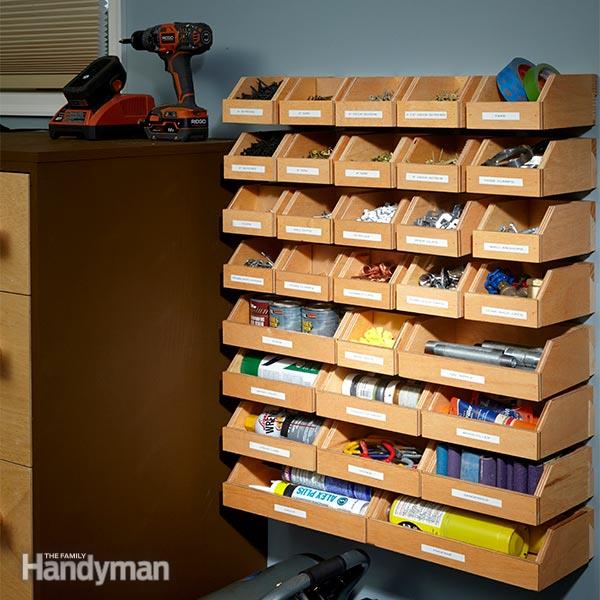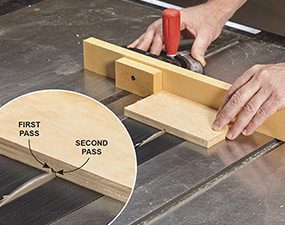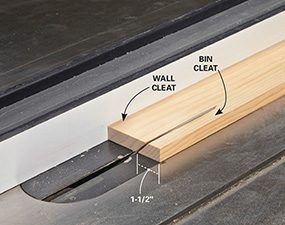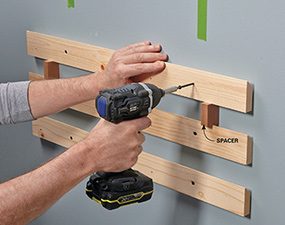Inventory management
DIY isn’t just about building and fixing things. It’s also about inventory management: maintaining a supply of the stuff you need and knowing where to find it. This simple bin system is the perfect project to get you organized with everything from bolts to screws. It’s modeled on the bolt organizer systems used in cabinet shops, plumbers’ vans and mechanics’ garages.
The materials cost for the bolt organizer bins shown here is $30 to $55, depending on the type of plywood you choose. A store-bought light-duty system would cost just a few bucks more, but these homemade bins offer two big advantages: They’re far tougher than plastic bins, and you can customize them to suit your equipment. Plus, they make the perfect scrap-wood project because all the parts are small. We built these bins from leftovers and didn’t spend a dime.
French Cleats Make It Neat
This simple hanging system- made from a 1×4 cut at a 45-degree bevel-lets you grab a bin and take it to the job, or rearrange bins instantly as your needs change.
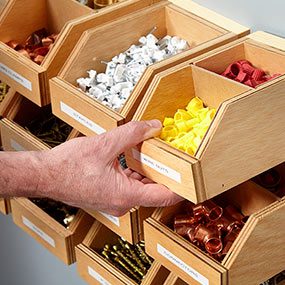

Rip strips of plywood to width on a table saw, then cut them to length with a miter saw. Clamp a scrap of plywood to the saw’s fence to act as a stop block. That lets you cut identical lengths from several strips with one chop.
Photo 2: Cut divider slots
Mount a fence on your saw’s miter gauge and position a stop block on the fence. Run the bin side across the blade. Then rotate the side 180 degrees and make a second pass to widen the slot. Caution: You have to remove the guard for this step. Be extra careful!
Photo 3: Cut the cleats
Tilt the blade to 45 degrees and set the fence so that the bin cleat is 1-1/2 in. wide. Getting the fence positioned may take some trial and error, so cut a test scrap first. Our guard was removed for photo clarity. Use yours!
Begin by measuring the items you want to store. We found that the basic bin was just right for most stuff: nuts and bolts, construction screws, plumbing and electrical parts. For larger items, we made a few bins wider, but didn’t change the bin sides (A). That approach is the most efficient because the sides are the most complex parts and changing them requires more fuss.
Once you’ve determined the sizes you want, fire up your table saw and rip plywood into strips. If you’re following our plan, you’ll need strips 1-3/4, 3-1/2 and 6 in. wide. Then cut the strips to length, making parts for one box only. Test-assemble the box to check the fit of the parts. Note: “Half-inch” plywood is slightly less than 1/2 in. thick, so the bin bottom (B) needs to be slightly longer than 6 in. Start at 6-1/8 in., then trim as needed. When you’ve confirmed that all the parts are the right size, mass-produce them by chopping the strips to length (Photo 1).
If you want dividers (E) in any of the bins, your next step is to cut the divider slots. Set your table saw blade to a height of 3/16 in. Screw a long fence to your miter gauge and run the fence across the blade to cut a notch on the fence. Position a stop block 3-1/4 in. from the center of the notch. Place a side (A) against the block, run it across the blade, rotate it and cut again (Photo 2). Check the fit of a divider in the slot and reposition the block slightly to adjust the width of the slot. It may take two or three tries before you get the width right.
When you’re done cutting slots, it’s time to clip off one corner of each side. Set your miter saw 45 degrees to the right. Clamp on a stop block and “gang-cut” sides just as you did when cutting parts to length (similar to Photo 1). Remember this: Slotted sides require left/right pairs. For every side that you cut with the slot facing up, cut another with the slot down.
Next, cut the cleats (Photo 3). The 45-degree bevel cuts will leave sharp, splintery edges, so crank the table saw blade back to zero degrees and shave 1/8 in. off each cleat before cutting them to length.
To see more garage shelving plans that utilize French cleats, see Custom Garage Storage.
Figure A: Basic Bin
The inside dimensions of this garage shelving bin are 4” wide by 6” long by 3” deep.
Assemble them and hang them up 
Join the parts with glue and brads. The glue will provide plenty of strength, so drive only as many brads as needed to hold the parts together while the glue sets.
Photo 5: Mount the wall cleats
Mark the stud locations with tape and screw on the lowest cleat. Then work your way up the wall, using spacers to position each cleat.
Assembly is fast and easy with glue and an 18-gauge brad nailer. First, tack the back (C) to the bottom (B), then add the sides (A), the front (D) and finally the cleat (F). After assembly, we wiped on two coats of Watco Danish Oil (available through our affiliation with Amazon.com) to keep the wood from absorbing greasy fingerprints and oils from hardware.
When mounting the wall cleats, start at the bottom. Make sure the bottom cleat is level and straight. Then cut spacers at least 1-3/4 in. tall and use them to position the remaining wall cleats (Photo 5). Larger cleats will create more space between rows of bins, making it easier to reach in and grab stuff. Bins filled with hardware put a heavy load on the cleats, so drive a screw into every wall stud.
Required Tools for this Project
Have the necessary tools for this DIY project lined up before you start—you’ll save time and frustration. 4-in-1 screwdriverAir compressorAir hoseBrad nail gunCordless drillMiter sawSafety glassesTable saw
Required Materials for this Project
Avoid last-minute shopping trips by having all your materials ready ahead of time. Here’s a list. 1 x 4 x 8′ pine (3)1-in. brads2-1/2-in. screws2′ x 4′ x 1/8″ hardboard (1)4′ x 8′ x 1/2″ plywood (1)
Read more: familyhandyman.com

